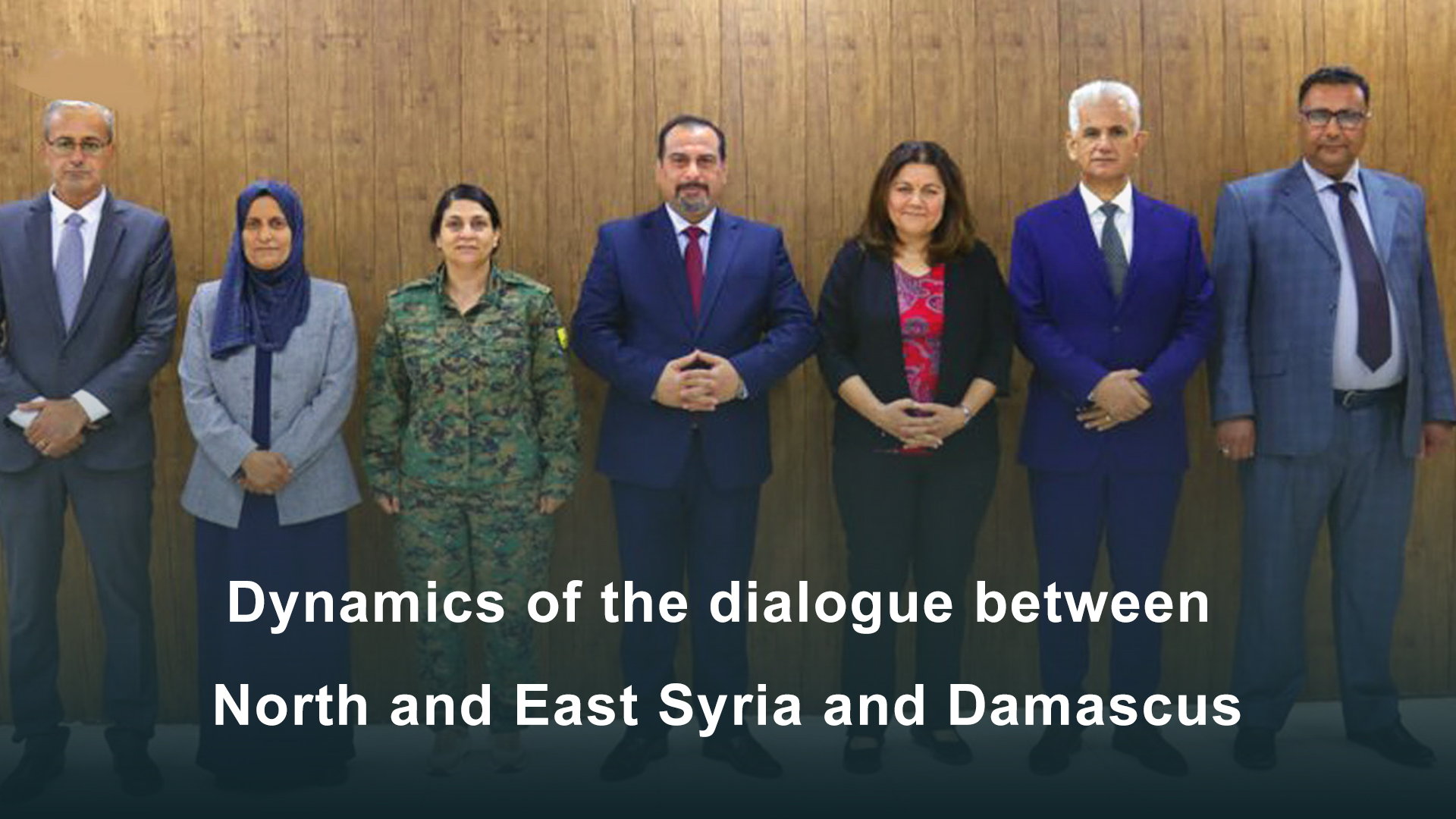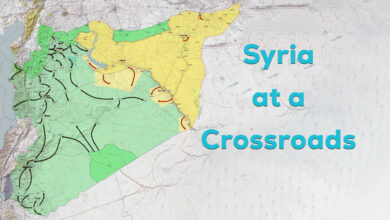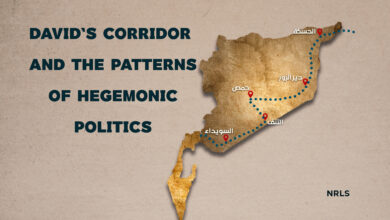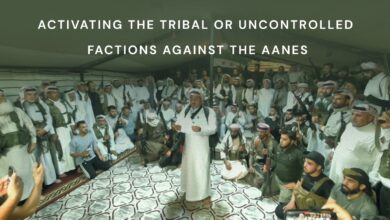Dynamics of the dialogue between North and East Syria and Damascus

The Syrian crisis was not only based on the overthrow of the regime; rather it has extended for more than half a century, and was based on dogmatism and a refusal to recognize the components of the Syrian people. This regime, the ‘’defunct regime,” worked to dismantle the Syrian fabric to ensure its continuity, which led to a stifling crisis between the components of the Syrian people and the central authority. The popular uprising that swept the region, including Syria, was not only aimed at overthrowing the ruling regimes; it was also aimed at achieving political, cultural, and economic rights within a system and constitution that preserves those rights and prevents any new ruling authority from reusing the methods of the defunct regime to serve its own.
As much as there were positive results in the Syrian crisis that ended the oppressive regime in Syria, it also produced negativeresults that created a crisis between the components of the Syrian people, the cause of which was primarily those military factions linked to a foreign “regional” agenda, especially those operations related to demographic change in the occupied north of Syria, and the distance of those factions from the aspirations of the Syrian people for freedom and democracy, and their commission (the mercenaries of Al-Amshat (and the Hamzas and Sultan Murad) massacres against components, such as the Alawite and Druze components, regardless of the violations committed by mercenaries or the Turkish occupation state against the Kurdish people in its occupied areas (Afrin, Gire Spi and Sere kaniye ) , or those committed by the Baath regime over half a century, as well as the military operations that continued even after the fall of the regime.
The new regime’s major dilemma lies in its failure to recognize the diverse components of the Syrian people. This is demonstrated by the constitutional declaration, the imposition of a one-party system, and its rejection of the sacrifices made by those who fought to bring the Syrian people to a better future based on a new, democratic, pluralistic system that would end the suffering of the Syrian people and preserve the unity of Syrian territory.
The importance of dialogue in Syria
After the fall of the Assad regime on December 8, 2024, dialogue between the various components of the Syrian people and the active national forces became essential to resolve the legacy of the Syrian crisis over more than a decade and to eliminate the effects of the policies pursued by the Ba’athist regime for more than half a century, which were the primary reason for the disintegration of the Syrian fabric and the state it faces today.
Constructive dialogue and negotiations between these parties, away from foreign interference, will spare the Syrian people further crises that could engulf the country and potentially pose greater risks, as the dialogue will be between the components of the Syrian people and the national forces. If the national dialogue is overlooked or the negotiations fail, this could herald the disintegration of Syrian society and the tearing apart of the Syrian territorial integrity. Terrorist organizations may exploit this, whether to serve their own agenda in Syria or to serve the agenda of external parties that may wish to see the Syrian crisis continue. After the coastal massacres, the Syrian components have begun to fear a recurrence of the same scenario in their areas. Therefore, they are moving towards forming their own military councils to protect their people from terrorist factions and loose groups within the new Syrian army, and are also working to demand their constitutional rights. The current situation also requires plans and programs to better leverage practical experiences and expertise to confront common challenges; Which one A Syrian agreement or national dialogue will cut off the path to all forms of intervention, will serve as a means of eliminating pretexts, and will build good neighborly relations based on the supreme national interests.
Collaborative work between the Autonomous Administration and the Interim Government
-The Sheikh Maqsoud and Ashrafieh agreement and reaching a clear action plan that includes a timetable for Afrin and the return of the displaced to it, in addition to the file of prisoner exchange and emptying prisons on both sides. The Damascus authorities’ creation of pretexts may be a result of Turkish pressure particularly what regarding the prisoners of the Women’s Protection Units (YPJ) in their possession.
-The Abdi – Shara Agreement and the end of all attacks and military operations inside Syrian territory. were also discussed The Kurdish issue was also discussed as a Syrian national issue. The discussions covered the fundamental issues related to the autonomous administration and its institutions, as well as the military and security forces, and how to integrate them as part of Syrian national institutions. It was agreed to continue detailed negotiations through specialized committees, while examining the mechanisms for the work of sovereign institutions in coordination with Damascus, and ensuring the privacy of local institutions in a way that expresses the will of local communities in managing their affairs and representing their aspirations.
-A preliminary agreement about oil between the SDF and the Syrian government was reached. The Democratic Autonomous Administration affirmed that existing resources, such as oil, gas, etc…, belong to the Syrian people, and that it is prepared to hand them over to the authorities in Damascus after agreement is reached on the system of government in Syria.The Autonomous Administration’s desire to distribute Syria’s wealth in a way that achieves economic justice for all Syrians is considered a positive step on its part.
-Tishrin Dam Agreement and cessation of military operations around the Tishrin Dam axis.
-Al-Hawl camp, which houses thousands of ISIS families, has been the subject of discussions without reaching a final agreement on how to return Syrian families to their home areas and rehabilitate them for social reintegration.The SDF’s permission for a delegation from Damascus, for the first time, to visit al-Hawl camp is considered a goodwill gesture aimed at resolving the camp’s crisis, or even resolving the nature and form of its management.
-There are issues still under discussion, such as the education file.
Regardless of the obstacles placed by the Damascus authorities in the way of understandings and agreements concluded with the Autonomous Administration, which may be the result of undeclared regional interventions, the mere existence of periodic and continuous meetings creates a kind of reassurance among the Syrian people in all its components. The agreement between the authorities in Damascus and the Autonomous Administration in the North and East of Syria region will constitute the beginning of a new phase for all of Syria and all its components to begin the phase of political construction with the participation of all spectrums , and it will also lead to To bring down the curtain on a period during which the Syrians lived through all forms of misery, deprivation and tyranny , and willend all the bloody conflicts since the Baath regime took control until now .
Autonomous Administration also believes that the success of the upcoming dialogue requires not placing preconditions on it to achieve the goals, in addition to the importance of clear interaction to understand and comprehend the Administration’s project.
Key External actors in Syria
Before the regime’s fall, Syria was divided between two opposing factions. The first faction ended with the regime’s fall—the former Syrian regime, Iran, and Russia—while the second faction—the United States, Turkey, along with Israel and France—now held absolute control over the Syrian file.
These countries, despite their differences, remain partners and allies and can resolve their differences by setting mutual red lines while preserving their interests in Syria, regardless of the aspirations of the Syrian people. They also have influence over the new regime and can prevent it from taking steps that would strengthen democracy. They can impose their dictates on the interim government. Here, we specifically mention Turkey, the neighboring country that rejects any new form of Syrian government, insists on centralization, and rejects a new constitution that guarantees the rights of Syrian communities and the Kurdish people in Rojava. Unlike other countries (the United States, France, and Israel) which have no problem with the form of government in Syria’ centralized-federal- decentralized’’ they nonetheless emphasize the protection of the rights of Syrian “minority” communities.
Key internal actors
1-The transitional government headed by Ahmed al-Sharaa
Despite the foreign interventions that helped bring down the regime, Hayat Tahrir al-Sham was the main player in the military operations that ended the regime’s existence. It then formed a transitional government of a single color and a constitutional declaration that was rejected by most components of the Syrian population.
–Strengths
The interim government has been able to revitalize itself thanks to the significant support recently provided by Saudi Arabia, as well as international and regional interests that require openness to this government—the lifting of international sanctions on the new regime — the economic investments that began with the lifting of US, European, and Japanese sanctions—and the presence of regional powers (Turkey and some Arab countries) supporting it.
–Weaknesses
The insistence on a single color, the failure to represent the Syrian people in all their spectrums and components, the inability to curb the factions loyal to Turkey in occupied northern Syria, the presence of undisciplined factions within the formations of the new Syrian army, the military appointments of division commanders accused of committing violations and massacres, the existence of disputes with the Druze and Alawite components, the Autonomous Administration and the Syrian Democratic Forces, and the desire of these components to establish a pluralistic democratic system, the emergence of ideological differences between ISIS and interim President Ahmed al-Sharaa; which may pose a threat to them, especially with the presence of fighters, both foreign and Syrian, who still espouse the group’s ideology within the regime’s military and security institutions.
2-The Autonomous Administration of North and East Syria
The Autonomous Administration was formed in the midst of the Syrian crisis. It took a different path based on the principle of preserving and protecting its regions from terrorist organizations, liberating the regions from the terrorist organization ISIS in the eastern Euphrates, and not clashing with the former regime, nor even with the so-called Syrian opposition or its armed factions. It established an autonomous administration that guarantees the rights of all components in its regions, and is considered a model that could be the nucleus of a more comprehensive Syrian system based on democracy and pluralism. The Autonomous Administration possessed a disciplined military and security force composed of members of all components, “the Syrian Democratic Forces and the Asayish, ” which have extensive combat experience in fighting terrorist organizations and in spreading security.
–Strengths
The Autonomous Administration is considered one of the best models witnessed in the Syrian regions during the Syrian crisis before the fall of the regime, compared to the regions of the so-called Syrian opposition coalition, the “Interim Government” in the occupied north of Syria, and the region of Hayat Tahrir al-Sham, the “Salvation Government” in Idlib, and even the regions of the former regime. With its possession of the internal security forces, the ” Asayish “, it was able to spread security in its regions. It also possesses a large military force represented by the Syrian Democratic Forces, the SDF’s partnership with the international coalition in fighting ISIS and its continued support despite Turkish pressure to end this partnership, a cohesive social fabric among the components of the region, its possession of a social contract that guarantees the rights of all components in the region, the unity of the Kurdish ranks, and the attempts of some components in Syria to implement the Autonomous Administration model in their regions. The Kurdish component, which constitutes the second component of Syrian society, supports the demands of the Autonomous Administration to change the form of government in Syria and supports the drafting of a new constitution that guarantees the rights of all components of the Syrian people, in addition to the richness of its regions in underground resources and strategic crops.
–Weaknesses
It does not have an effective international support forcefor its political project, “demanding that the administration change the system of government in Syria to federalism or decentralization,” despite the international community’s affirmation of the rights of Syrian communities, Turkey’s continued hostility and its mercenaries toward the Autonomous Administration and the Syrian Democratic Forces, their impact on the security and economic situation in the region, and international interests that could impact its democratic project.
Points of difference and agreement that unite the two sides
-Points of disagreement between the two sides:
Each side has a different ideology, and there is disagreement between them about the form of governance in Syria (the transitional government insists on centralization, while the autonomous administration demands decentralization). There is also disagreement about the form of the new Syrian army (the transitional government insists on including the Syrian Democratic Forces (SDF) in the new Syrian army without any special status. Regional states have influence over this demand, while the SDF insists on its special status within the new Syrian army, especially since it is a partner of the international coalition in the fight against ISIS). The transitional government also demands extending its control over the entire geography of the autonomous administration in northeastern Syria, while the autonomous administration rejects this and emphasizes its gains, which were watered by the blood of tens of thousands of martyrs and wounded throughout the Syrian crisis. There are other points of disagreement over administrative and educational issues…
-Points of agreement between the two parties
The two sides agree to form a new Syrian army; that is the Syrian Democratic Forces do not refuse to join the new Syrian army, which is a fundamental point that can be built upon and understandings reached in the near future to establish a new national army according to a specific structure. There is an agreement between Mazloum Abdi, commander of the Syrian Democratic Forces, and Mr. Ahmed al-Sharaa, the interim Syrian president, which can be used as a basis for broader political, economic, and military understandings. There is a degree of trust between the two sides through the committees and agreements concluded between them. Most importantly, there has been no military clash between the two sides so far, which is a positive indicator for the success of any dialogue or negotiations between the two sides in the future.
The negotiations between the joint Kurdish delegation and the transitional government
Following the unification of the Kurdish ranks, a delegation was formed to negotiate with the transitional government regarding the rights of the Kurdish people in Syria, as represented in the document that emerged from the Kurdish conference on May 26, 2025. This delegation is part of the autonomous administration delegation, which includes other components of the region, including Arabs, Syriacs, and Assyrians, and is part of the autonomous administration project. This delegation, which will travel to Damascus, will unite all components of the region as a single bloc to demand their constitutional rights and transform Syria into a pluralistic democratic system that guarantees the rights of the Kurdish people and the rights of all Syrian components. The success of the Kurdish delegation negotiating with the interim government will serve as the cornerstone for a permanent constitution that guarantees the rights of all Syrian components.
Within this context; The national dialogue between two sides is the axis of the solution in Syria. It could spare Syria a civil war and a new crisis with far greater repercussions than the crisis that swept the country during the time of the former regime. Its impact could extend beyond Syria’s interior to encompass the entire region.
There are strengths and weaknesses for both sides, but the common ground and common interests can be built upon, and these strengths can be leveraged to build a pluralistic, democratic state. The strong partnership between the SDF and the international coalition to fight ISIS terroerist organization, and the international community’s demands for the Syrian Interim Government to cooperate with the SDF to fight terrorism, constitute a point of great importance for the new regime, which is still being tested despite the lifting of sanctions. This is especially true after ISIS announced an ideological dispute with Ahmed al -Sharaa , and the organization launched terrorist attacks against the government of Ahmed al-Sharaa.Therefore,it can be relied upon to increase coordination between the Syrian Democratic Forces and the New Syrian Army , especially in light of Shara’s inability to control the factions under the banner of the New Syrian Army , and the presence of fighters who still adopt the organization’s ideology. The International Coalition has refused the Syrian Army’s accession to the International Coalition to fight ISIS, which falls within the framework of the International Coalition’s lack of trust in the new regime. However, direct coordination with the Syrian Democratic Forces and reaching an agreement on the structure of the Syrian Army will be a strong incentive for the coalition to accept the inclusion of the New Syrian Army in the International Coalition in the fight against ISIS. The presence of the SDF and the International Coalition behind it will constitute significant support for Shara’a in seriously fighting the organization and in instilling trust between the regime and the international community.
The Autonomous Administration’s assertion that the resources in its regions, such as oil, gas, etc…, belong to the Syrian people , and that it is prepared to hand them over to the authorities in Damascus , as well as the interim government’s ability to implement the agreements concluded with the Syrian Democratic Forces, which relate to the ceasefire, and its ability to control the factions loyal to Turkey, and the return of the displaced to their areas in “Afrin, Gire Spi and Sere Kaniye ” will be major steps towards a democratic Syria, and a unified constitution that preserves the rights of all components of Syrian society.
The new regime is still weak; its weakness stems from its marginalization of components, its inability to maintain security across the entire Syrian geography, and the presence of areas still occupied by regional states. However, the most important dilemma for reaching a constructive national dialogue remains Mr. Ahmed al-Sharaa’s ability to rid himself of Turkish dependency, which constitutes the greatest obstacle to reaching final agreements between him and the Autonomous Administration, or agreements with other Syrian components, such as the Alawites and Druze. Turkish influence on Mr. Ahmed al-Sharaa and his transitional government is still evident, and Mr. Abdullah Ocalan’s peace initiative may end and invalidate Erdogan’s arguments regarding the Autonomous Administration and the form of the regime in Syria, and thus may contribute to bringing Syria to safety.




